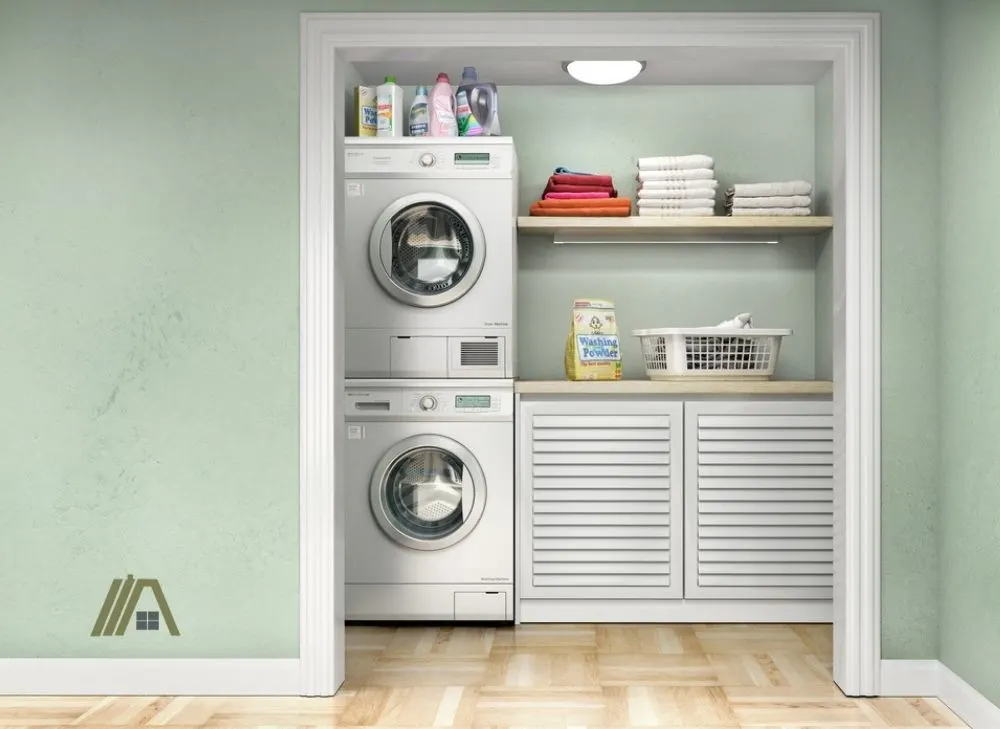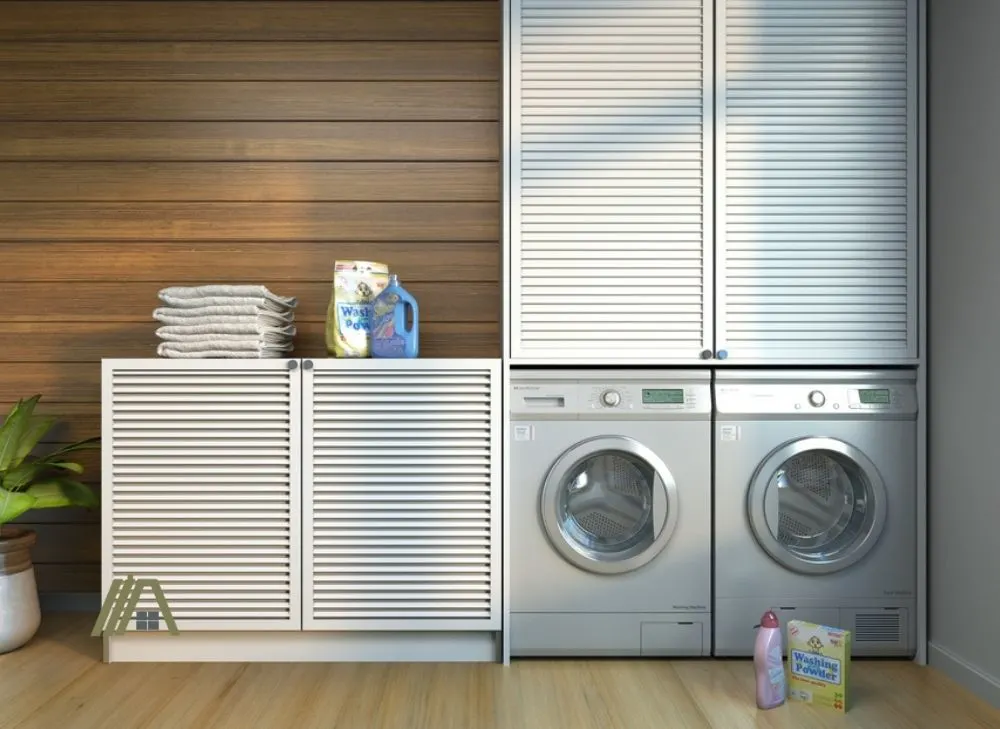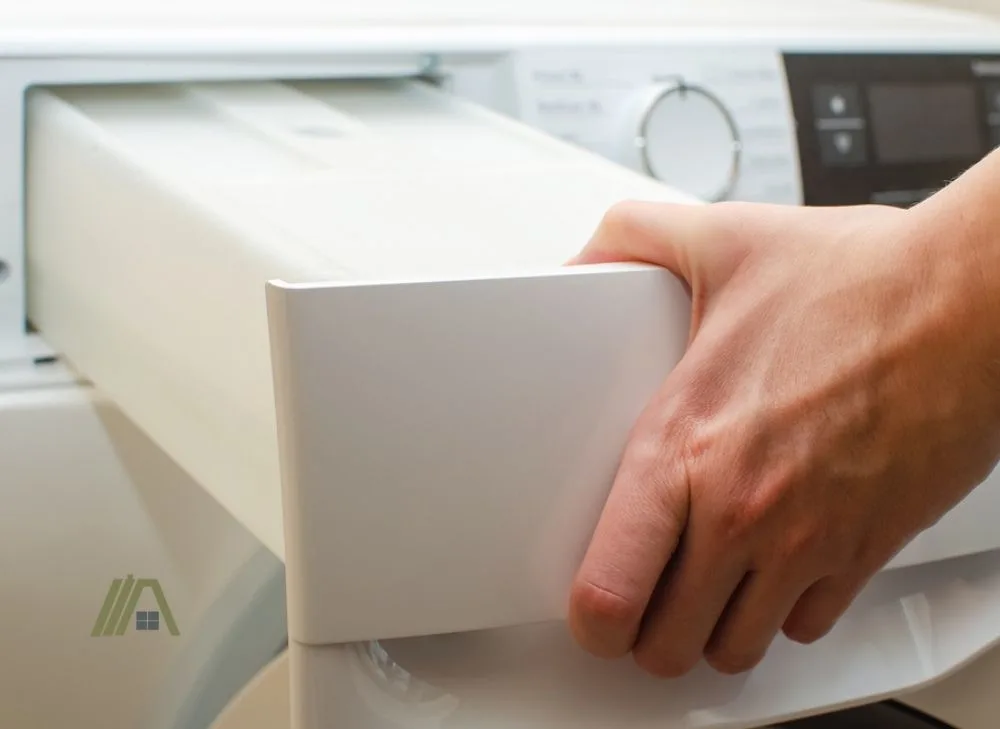| Pros | Cons |
| Dryer can be installed anywhere. | Releases heat into the room the dryer is located. |
| No need to create holes in the wall to fit a vent. | Might require that you empty the condensation tray after every round. |
| Doesn’t require duct maintenance. | Smaller load capacity. |
| Easy to install. | Takes longer to dry cloths. |
| More energy efficient than vented dryers. | More expensive than vented dryers. |

Ventless dryers can be used anywhere. There are no ducts to install and maintain. They are more efficient than vented units. Ventless dryers can release some heat and moisture into the room. They have smaller load capacities, longer drying times, and are more expensive to buy than vented ones.
Ventless Dryer Pros
Greater Choice of Dryer Location
Unlike vented dryers, which are usually connected to a vent that expels humid air to an exterior location, ventless dryers do not need to be connected to a vent. This means that it does not need to be located with easy access to an external wall or to the attic and roof.
If you do not have the space for laundry appliances, then a regular-sized vented dryer, which is usually 27”, might not be an ideal fit. A ventless dryer on the other hand features models that are small enough to fit under counters or inside closets.

You do not have to stress over a dedicated laundry room if you do not have space for one in your home. You can install a ventless dryer anywhere in your house without worrying about ruining the wall’s surface to fit a vent.
No Additional Holes in the House
Ventless dryers do not vent air outside, so you wouldn’t have to create a hole in your wall in order to install a vent. This means one less wall to disfigure.
This quality is great for people who do not have a laundry room and do not wish to have dryer vent holes in other parts of the house.
If you aren’t sure of where you’d like to place your dryer or do not want to make any permanent changes to your home then a ventless dryer is a great choice.
Apart from the aesthetics factor, another downside of having multiple holes around a house is that they might leave your home vulnerable to air leaks, making it less energy-efficient.
Save Time on Duct Maintenance
It’s recommended that dryer ducts be cleaned at least twice a year. Depending on how often the dryer is used and the size of the household, the duct might have to be cleaned more than twice.
Although you do not always require a professional to clean the ducts, professional help is sometimes needed for a deep clean.
A ventless dryer would save you the time and added expenses of employing a professional to clean the duct if you aren’t disposed to doing it yourself.
A vented dryer demands that you clean both the dryer unit and the vent occasionally as well as empty the lint filter after each load. Whereas if you’re using a ventless dryer, you only have to clean the dryer unit and empty the lint filter.
Clogged dryer ducts are a fire hazard so, you can rest easy knowing that you do not have to worry about a lint-filled duct.
Easier Installation Compared to Vented
Setting up a ventless dryer is a pretty straightforward procedure. The only requirement for the appliance to start running is a power receptacle.
Some ventless dryers might fit into a 120V outlet but most require a 240V outlet to function. If you are skillful enough, you can install the outlet or you might have to hire an electrician.
Please note: some places require all electrical work to be done by a licensed professional and even if you have the skills doing it yourself will be against the law.
If you already have a matching receptacle in place, you wouldn’t have to perform any technical task while setting up your ventless dryer.
Installing a vented dryer could be a complicated undertaking because you would have to install the ductwork and vent. This procedure often requires professional help and amateur DIY-ers might find it tricky and time-consuming.
Greater Energy Efficiency

Not only do ventless dryers consume less energy than vented dryers, but they also help reduce the energy used by the HVAC system. They don’t create air leaks nor exhaust air outside, which would put more load on the HVAC system that would have to draw in the same amount of air and cool/heat it again.
A vented unit operates by drawing in conditioned air from the room, expelling it, and drawing in more air from the room until the clothes are dry. But a ventless dryer doesn’t vent to the outdoors, instead, it reheats the air and uses it for the next loop.
Thus, vented dryers cause your HVAC system to work harder to bring the room to your desired temperature. It would also require additional energy to heat up air from scratch as it expels humid air.
Ventless dryers do not take up as much conditioned air, making them more energy-efficient.
The Type of Ventless Dryer Affects Its Efficiency
There are two main types of ventless dryers: condensers and heat pump dryers. Neither of them features a vent. They both dry clothes by heating up, cooling, condensing, and then reheating air.

However, although they are similar in appearance, set-up, and general mechanism, they do not operate the same way.
| Heat pump dryers | Condenser dryers |
| Lower operating temperature. | Higher operating temperature. |
| Uses heat pump technology to save energy. | Not as energy-efficient. |
| Doesn’t feature a heating element. | Uses a heating element. |
Ventless dryers are typically more energy-efficient than vented units. But because of their mode of operation, heat pump dryers use much less energy than condenser units.
Condenser Dryer
Condenser dryers are probably the most popular type of ventless dryers because they dry clothes relatively fast compared to the heat pump models.
Their drying speed can be attributed to the presence of an electric heating element. As a result, they run at a temperature higher than the one used by heat pump dryers.
As a general rule of thumb, the higher a dryer’s operating temperature, the higher the dryer’s energy consumption.
Condenser units consume about 20% more energy than heat pump dryers.
Operating a vented dryer would cause your HVAC system to work extra hard to bring the room to your desired temperature. This is because traditional dryers expel heated air outside. Thus, they continually draw in conditioned air from the room. Condenser units recycle used air, so they’d cause less strain on your HVAC system.
Thus, although condenser dryers aren’t as energy efficient as heat pump dryers, they do not consume as much energy as traditional dryers.
Heat Pump Dryer
Heat pump dryers are the most energy-efficient dryer option available.
Other dryer models feature a heating element. However, heat pump dryers do not. Instead, heat pump technology is used to dry clothes in a manner similar to the operations of refrigerators and air-conditioning units.
In heat pump dryers, a compressed refrigerant in coils is used to heat the air. After the air collects moisture from clothes in a drum, the air passes to an evaporator. The refrigerant in the evaporator is not compressed; thus, it is cold, and it cools any air that passes through, condensing moisture and collecting it in the process.
After the air has been rid of moisture, it passes over the coils again to get reheated before continuing to the drum to evaporate more water from the clothes.
The absence of a heating element in heat pump dryers means that their drying temperature is significantly lower than that of other units.
Their low operating temperature causes them to take longer to dry clothes. H
The energy consumed by an average heat pump dryer is usually half the amount required by a regular vented unit.
Ventless Dryer Cons
More Heat Released Into Room
Ventless dryers do not exhaust heated air outside. Instead, moisture is extracted from the air, the air is cooled by a heat exchanger and then recycled until the clothes are completely dry.
While this makes ventless dryers energy-efficient, if the appliance is left running for long, the dryer could become heated. This heat might be released into the room, especially in the area where the dryer is located. This would ultimately affect the overall air quality in the room.
Additionally, moisture could condense on the underside of the dryer. If the moisture is repeatedly left to settle on the surface, it could lead to mold and mildew growth.
Have to Empty Condensation Tray
While a vented dryer exhausts both moisture and hot air, ventless dryers feature a condensation tray where the moisture from clothes is deposited.

These trays aren’t always connected to an outlet and are emptied manually, ideally after every load. It’s best to not wait until the tray is full before emptying it.
Condenser dryers typically feature only a containment tray. However, most heat pump dryers feature a drain hose as well as a tray. So, rather than allowing the water to drain into the tray, you can connect the hose to the dryer, which lets the moisture drain into your laundry tub or basin.
However, the hose isn’t a practical option if you have nowhere for the water to drain.
If you aren’t up to emptying water from the containment tray after every load, then a ventless dryer might not be the best choice for you.
Smaller Load Capacity
Ventless dryers are relatively smaller than vented units, which means that their drum capacity is smaller.
So, if you have a large household or go through a lot of clothes, using a ventless unit would be a time-consuming experience.
Even regular households might have to go through multiple cycles. This is one of the reasons why ventless dryers aren’t popular in the US even though they are a household name in Europe.
For instance, average ventless dryers can take only a king-size comforter in a cycle, while regular vented units can take more than that.
If you’re used to the drum size of a vented dryer, changing to a smaller unit would definitely be frustrating.
Clothing Takes Longer to Dry
Not only do you have to dry your clothes in small batches, but you would also have to wait longer to retrieve them or move on to the next load.
If you have a busy schedule or you prefer not to spend so long on chores, then a ventless dryer is certainly not the right fit for you.

Ideally the smaller the load the quicker the drying time and vice versa.
A ventless dryer could take 50% longer than a regular dryer to dry identical fabrics. Some units even take double the time required by a vented unit.
A condenser unit dries clothes 20% faster than a heat pump dryer.
Costs More to Buy
Although they are more energy-efficient than vented units, the initial cost of purchasing a ventless dryer is a lot more expensive.
Vented dryers are priced between $300 to $1,500. Condenser dryers are not as expensive as heat pump dryers and they cost between $700 to $2,200. That’s almost twice the price of a standard full-sized vented dryer.
If you intend to go for a heat pump unit, you’d be looking to spend between $1,400 to $3,500. That is a lot of money to spend on a dryer, bearing in mind that it isn’t a combo appliance and you could get a vented dryer and washer combo unit (amazon link) for about $1,100.
Source
https://www.mrappliance.com/blog/2019/november/the-pros-and-cons-of-a-ventless-dryer/
https://www.uakc.com/blog/is-a-ventless-dryer-a-good-choice-for-your-home/
https://www.youtube.com/watch?v=AGpyrT2cfu8
https://ars.repair/dryer-repair/unique-problems-that-come-with-ventless-dryers/
